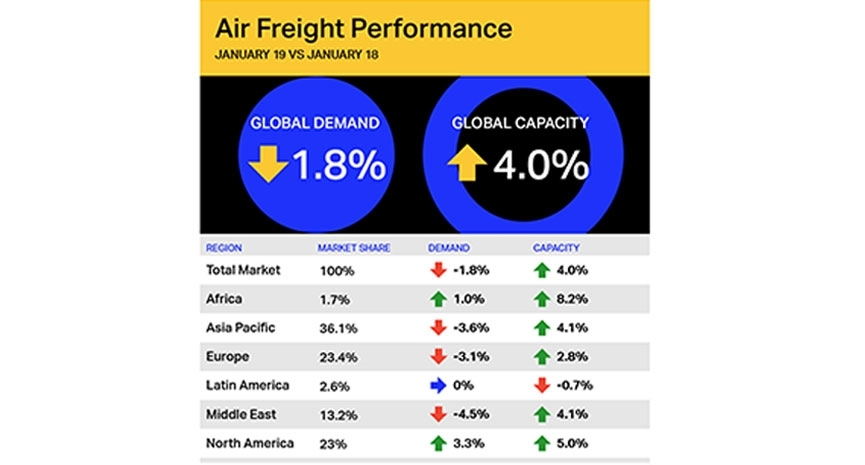Global air freight demand weakens in Jan’19; Africa posts upward momentum: IATA
The International Air Transport Association (IATA) has released global air freight market data showing that the demand measured in freight tonne kilometres (FTKs), decreased 1.8 percent in January 2019

Mar 07, 2019: The International Air Transport Association (IATA) has released global air freight market data showing that the demand measured in freight tonne kilometres (FTKs), decreased 1.8 percent in January 2019, compared to the same period last year. This was the worst performance in the last three years.
The freight capacity, measured in available freight tonne kilometres (AFTKs), rose by 4.0 percent year-on-year in January 2019. This was the eleventh month in a row that capacity growth outstripped demand growth.
"Air cargo markets contracted in January. This is a worsening of a weakening trend that started in mid-2018. Unless protectionist measures and trade tensions diminish there is little prospect of a quick rebound," said Alexandre de Juniac, IATA's Director General and CEO.
African carriers saw freight demand increase by 1.0 percent in January 2019, compared to the same month in 2018. Capacity grew 8.2 percent year-on-year. Seasonally-adjusted air cargo demand has now trended upwards for six months. And while seasonally-adjusted international freight volumes are lower than their peak in mid-2017, they are still 35 percent higher than their most recent trough in late 2015.
Middle Eastern airlines' freight volumes contracted 4.5 percent in January 2019 compared to the year-ago period. Capacity increased by 4.1 percent. Seasonally-adjusted international air cargo demand, which trended upwards for the past three months helped by stronger trade to and from Europe and Asia, has started to decline.

North American airlines posted the fastest growth of any region for the eighth consecutive month in January 2019, with an increase in demand of 3.3 percent compared to the same period a year earlier. Capacity increased by 5.0 percent. The strength of the US economy and consumer spending has helped support the demand for air cargo over the past year, benefiting US carriers.
Latin American airlines' freight demand was flat (0.0 percent) in January 2019 versus last year. Despite the economic uncertainty in the region, a number of key markets are performing strongly. Freight traffic within South America and between Central and South America grew at a double-digit rate in January. And demand on routes between North and South America also performed well. Capacity decreased by 0.7 percent.
Asia-Pacific airlines saw demand for air freight shrink by 3.6 percent in January 2019, compared to the same period in 2018. Weaker manufacturing conditions for exporters in the region, ongoing trade tensions and a slowing of the Chinese economy impacted the market. Capacity increased by 4.1 percent.
European airlines experienced a contraction in freight demand of 3.1 percent in January 2019 compared to a year ago. Capacity increased by 2.8 percent year-on-year. Weaker manufacturing conditions for exporters, and shorter supplier delivery times particularly in Germany, one of Europe's key export markets, impacted demand. Trade tensions and uncertainty over Brexit also contributed to a weakening in demand.
Demand for air cargo continues to face significant headwinds. Global economic activity and consumer confidence have weakened. And the purchasing managers index (PMI) for manufacturing and export orders has indicated falling global export orders since September 2018.


